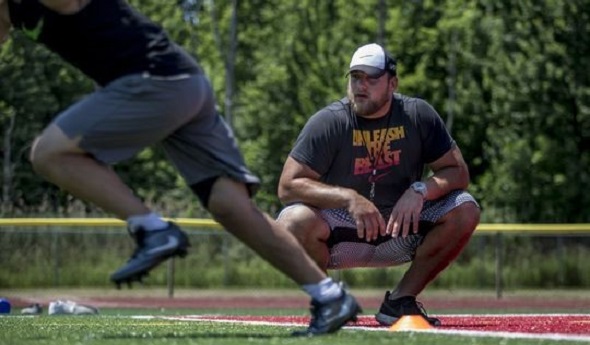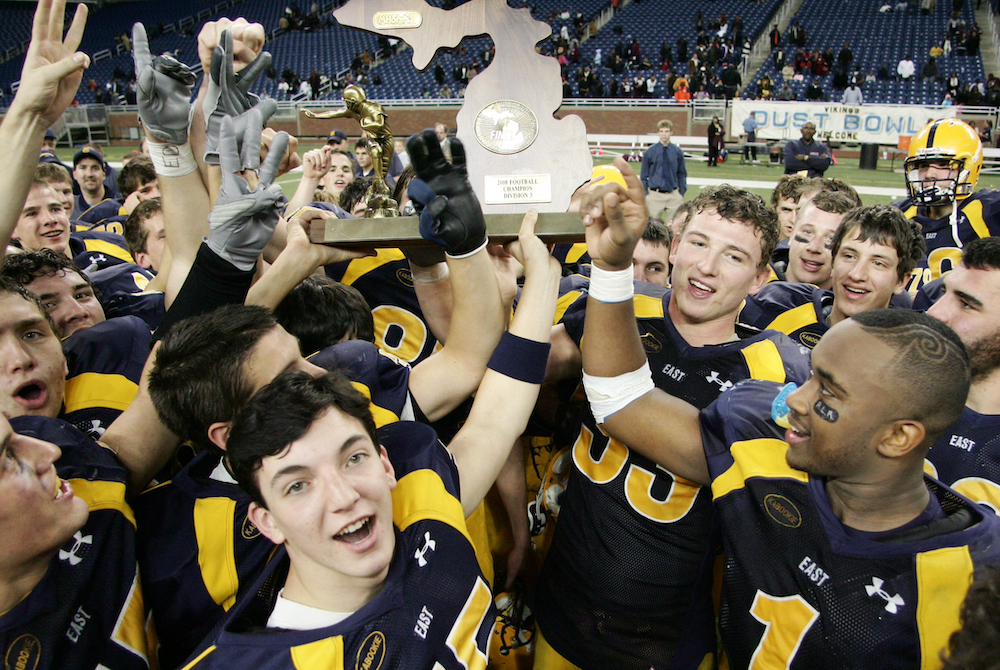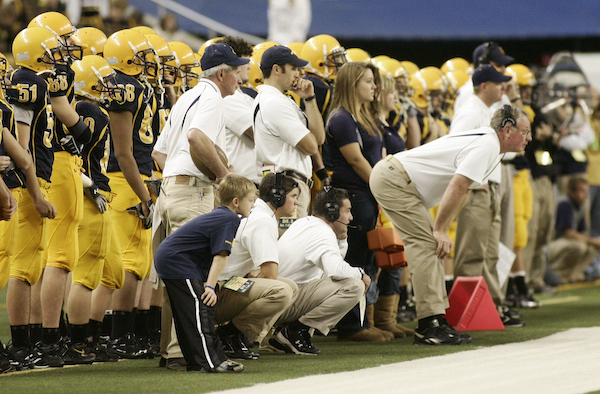
Lelito's Work Helps St Clair Athletes Play
By
Paul Costanzo
Special for MHSAA.com
May 31, 2017
If not for sports, Tim Lelito isn’t sure he would have finished high school.
 Now that he’s entering his fifth season in the National Football League, Lelito is doing what he can to make sure kids in St. Clair County don’t have to worry about that.
Now that he’s entering his fifth season in the National Football League, Lelito is doing what he can to make sure kids in St. Clair County don’t have to worry about that.
The Lelito Legacy Foundation has teamed with the Community Foundation of St. Clair County to grant $9,000 for county schools to cover athletic participation fees for students in need.
“I used sports as a vehicle for where I am now – to get to college and get through high school,” the 2007 St. Clair High School graduate said. “If I didn’t have sports, I don’t think I would have graduated high school at all. School wasn’t a priority; the horses that my grandparents raised were the priority, because that was our livelihood.
“Making it to college and being the first one in my family to graduate with a degree, sports was that vehicle for me to get that degree, and that really hit home with me.”
Five St. Clair County community partners were able to raise $4,500, and Lelito’s foundation matched. The funds will be able to cover participation fees for 116 students at St. Clair County high schools and middle schools during the 2017-18 school year.
 The Port Huron Schools Endowment Fund, East China School District Athletic Boosters and PTOs, the Community Foundation of St. Clair County’s Youth Advisory Council and its Marysville Community Fund, and the Capac Adolescents Preventing Abuse and Crime (CAPAC) Fund were the five partners.
The Port Huron Schools Endowment Fund, East China School District Athletic Boosters and PTOs, the Community Foundation of St. Clair County’s Youth Advisory Council and its Marysville Community Fund, and the Capac Adolescents Preventing Abuse and Crime (CAPAC) Fund were the five partners.
“It’s exciting to see someone who is not only successful and has come back to help his hometown, but he’s so humble about it,” Community Foundation Vice President Jackie Hanton said. “When we were in our meetings, it’s not about Tim. It’s that he has this vision to help kids who are like him.”
Lelito was a mauling all-state offensive lineman at St. Clair, paving the way for the team’s option attack. He was also an all-state thrower on the Saints’ track & field team.
Playing sports required a participation fee, something Lelito’s grandparents handled, even if they struggled to do so.
“When I was younger, my grandparents raised racehorses, and money was tight for a while,” Lelito said. “My grandparents put my brother and I in sports, and we always played sports. I didn’t realize how bad it was until I was older. They were pinching pennies together and taking care of us before taking care of their needs.”
Lelito earned a scholarship to Grand Valley State University, where – after redshirting as a freshman and being forced to take a medical redshirt his second year – he started 45 straight games and was named Offensive Lineman of the Year by the Great Lakes Intercollegiate Athletic Conference in 2012.
He was signed by the New Orleans Saints as an undrafted free agent in 2013, and worked his way into the rotation almost immediately, seeing action in 63 games during his four years in New Orleans and starting 24 games, including 13 in 2015.
This past offseason, Lelito signed a free-agent deal with the Tennessee Titans.
Throughout his NFL career, Lelito has given back, both to his hometown and his professional town. He has conducted free football camps for St. Clair County kids for the past few years.
 “He’s just a young man that I’ve continued to be impressed with how grounded he’s remained,” Bill Nesbitt, Lelito’s football coach at St. Clair, said. “He understands the big picture. His success is not just in playing at that level, but in helping others. That’s his great success.”
“He’s just a young man that I’ve continued to be impressed with how grounded he’s remained,” Bill Nesbitt, Lelito’s football coach at St. Clair, said. “He understands the big picture. His success is not just in playing at that level, but in helping others. That’s his great success.”
Funds for the participation fees will be given to the school districts in St. Clair County, and the schools will be tasked with selecting students most in need. In future years, Lelito hopes to help schools purchase equipment for kids in need, and eventually he wants his foundation to reach more than just athletes.
“My foundation isn’t just for kids in sports, it’s for underprivileged youth,” Lelito said. “I think moving forward, in the next five years, I want to be able to take care of a lot of kids in a very broad spectrum – in sports and arts and other extracurricular activities.”
That will take funding, but Lelito said he has found generous donors in St. Clair County.
“That’s why I bought a house here,” he said. “I love it here. I love the people; they’ll give you the shirt off their back. That’s why I wanted to put roots down here.”
With his efforts, Lelito is doing all he can to make it an even better place to call home. Nesbitt believes the funds could be the difference in playing sports as opposed to sitting out for some students, which he hopes will have a lasting effect.
“I think it definitely can have a positive impact that way,” Nesbitt said. “Hopefully, in a larger, greater, grander sense, these kids who are participants could one day give back themselves. If they are able to go on and have some success, maybe they could remember that somebody had helped them out and do the same.”
 Paul Costanzo served as a sportswriter at The Port Huron Times Herald from 2006-15, including three years as lead sportswriter, and prior to that as sports editor at the Hillsdale Daily News from 2005-06. He can be reached at [email protected] with story ideas for Genesee, Lapeer, St. Clair, Sanilac, Huron, Tuscola, Saginaw, Bay, Arenac, Midland and Gladwin counties.
Paul Costanzo served as a sportswriter at The Port Huron Times Herald from 2006-15, including three years as lead sportswriter, and prior to that as sports editor at the Hillsdale Daily News from 2005-06. He can be reached at [email protected] with story ideas for Genesee, Lapeer, St. Clair, Sanilac, Huron, Tuscola, Saginaw, Bay, Arenac, Midland and Gladwin counties.
PHOTOS: (Top) Tennessee Titans offensive lineman Tim Lelito watches an athlete work out during a camp he conducts in the St. Clair area. (Middle) Lelito during his high school career at St. Clair. (Below) Lelito, middle, has worked this offseason to help pay participation fees for athletes in need of financial assistance. (Top and below photos courtesy of the Port Huron Times Herald.)

EGR 5-Year Title Run Remains Awe-Inspiring, Product of More Than Talent Alone
By
Steve Vedder
Special for MHSAA.com
November 25, 2022
It was Peter Stuursma's first year at East Grand Rapids and while the wolves weren't necessarily knocking at the door, they were definitely on the prowl.
The tradition-rich Pioneers football team had slumped to an uncharacteristic 3-6 record in Stuursma's first season as varsity head coach in 2000, and there were subtle signs a community used to winning was growing restless with the program's direction.
That's when Stuursma bumped into one of his players coming out of the weight room, and the two had a quick conversation which he clearly remembers 22 years later.
"It was this senior offensive lineman and all he said was, 'Don't worry about it Coach, it's not going to happen again. We got this,’" Stuursma said. "We had just gone 3-6, and I'm wondering how we're going to get this going and that they might get rid of me. You never underestimate what people can do."
East Grand Rapids, under legendary coach George Barcheski, had been the dominant football program in West Michigan with 28 winning seasons over 29 from 1970-99, and 38 victories in 39 games from 1993-95, along with Class B championships in 1976 and 1983. After Stuursma replaced the retiring Barcheski,, some in the community were expecting more of the same when it came to success.
Those fans never dreamed what they would see as the Pioneers promptly pieced together arguably the greatest decade-long stretch in Michigan high school football history – and without doubt one of the most incredible five-year runs of dominance.
Even that optimistic offensive lineman couldn't have imagined a remarkable 126-7 record over the next 11 years, a 40-3 MHSAA Tournament mark and seven Finals championships. Five of those titles (2006-10) came in a row, a feat accomplished just three times in the now 46-year history of the playoffs.
 The five straight championships were part of an amazing era that Stuursma and his players say has not diminished with time. They recall no single factor explained going 67-3 overall over those five seasons. There was talent, obviously, but coaching, tradition, confidence and strength of community all played vital parts. There were Thanksgiving practices attended by hundreds of former football alumni, dedicated fan support that included playing before more than 30,000 fans at least twice at Ford Field, and a program-wide attitude that, while some may call it a cliché, proved that success did indeed breed success.
The five straight championships were part of an amazing era that Stuursma and his players say has not diminished with time. They recall no single factor explained going 67-3 overall over those five seasons. There was talent, obviously, but coaching, tradition, confidence and strength of community all played vital parts. There were Thanksgiving practices attended by hundreds of former football alumni, dedicated fan support that included playing before more than 30,000 fans at least twice at Ford Field, and a program-wide attitude that, while some may call it a cliché, proved that success did indeed breed success.
"I'm in awe of the scope of things," said Stuursma, whose team used back-to-back Division 3 championships in 2002-03 as a springboard to later success. "Because we had won a couple times before it just started to feel normal. We had such support the community used to think Thanksgiving break ended at Ford Field."
EGR teams would find all kinds of ways to win during the five-year title stretch. The 2009 team, for instance, barreled through its first four playoff opponents by a combined score of 164-29 until a 24-21 win over Orchard Lake St. Mary’s in the Final. The 2010 team had to win three playoff games by eight points or fewer to finish off its perfect 14-0 record. And then there was the wild 46-39 five-overtime win over St. Mary's in the 2007 Final during which the Pioneers had to score on all five possessions in overtime to outlast the Eaglets.
While teams always seemed to find ways to get the victory, former players remember what it was like to be part of a seemingly endless tradition of success on the football field.
"One of the things that was so special about East Grand Rapids were the expectations," said Luke Glendening, a running back on the 2006 team who has gone on to a long NHL career with the Detroit Red Wings and Dallas Stars. "During the game I'd look around and see guys who had played here a long time ago. I viewed it as a privilege to have the opportunity to play before the alumni and community."
Quarterback Ryan Elble, who completed a combined 34 passes for 483 yards and seven touchdowns during the 2008 and 2009 Finals, also used the word "honored" to describe his high school experience.
"The culture was to win. Coach Stuursma made it fun, and it always seemed to take shape on the field," said Elble, who went on to play baseball at Miami (Ohio) "I think each team had different skill sets, but at the end of the day it was our culture and putting in the work to spend Thanksgiving weekend at Ford Field."
The players point to that winning culture over talent. Elble said he played with only one eventual Division I college player in linebacker/running back Trent Voss, who went on to Toledo. Nobody wins without talent, of course, but they point to many other factors as being just as critical. Because EGR coaches would always work juniors into the lineup, Stuursma said the program faced only one major rebuild, in 2007. That team wound up 13-1 and the second of those five straight champions.
 "We had some incredible players," said Stuursma, who left EGR in 2016 to lead Hope College to two Michigan Intercollegiate Athletic Association titles, three second-place finishes and a 46-15 overall record over his seven seasons. "We returned only two starters (in 2007), but we still had good guys who wanted to win."
"We had some incredible players," said Stuursma, who left EGR in 2016 to lead Hope College to two Michigan Intercollegiate Athletic Association titles, three second-place finishes and a 46-15 overall record over his seven seasons. "We returned only two starters (in 2007), but we still had good guys who wanted to win."
The players say the culture started with Barcheski and the program's tradition. As Hope College's coach, Stuursma said there’s a similar common thread among schools he sees on recruiting visits: a winning tradition that, in Stuursma's words "screams excellence," from every corner of the building. He sees it the minute he walks into some schools, and East Grand Rapids had the same culture before he arrived. The past players say it played a major part in their careers.
That tradition didn't start with the five straight titles, said former quarterback Kyle Cunningham, who played on the 2002-03 teams and went 46-0 over four years from his freshman to senior seasons. Those two championship teams’ most recognizable player was running back Kevin Grady, who still holds multiple MHSAA records including for career rush yardage and went on to play at University of Michigan.
"We worked hard and had a lot of pride," he said. "I remember watching film of earlier teams, and I remember hoping our team could stand up the same way."
While the players point to tradition and community, Ryan Blair, a tight end/defensive tackle on the 2006-08 champion clubs, said talent remained critical – but EGR was outmanned physically in some of those title games. That's when camaraderie and the confidence that someone was going to make a key play took over. The Pioneers' remarkable run was teeming with such plays.
"Certainly we were never one of the biggest teams there, we never had a big size advantage in any game," he said. "But we had this camaraderie on every team. We had guys who really liked playing with each other. When things got tight we stuck together, and we'd fight to the fourth quarter or beyond."
Despite the long odds of winning a single state title let alone repeating, Stuursma believes there could be a team one day which wins six straight. That team will have the same characteristics of those EGR teams – the talent, coaching, tradition and fortune of catching timely breaks – but it can be done, he said.
"Absolutely," Stuursma said. "The only record I can think of that won't be broken is Wayne Gretzky's (NHL) scoring record. It will take a lot, but records are made to be broken. I think high school football is on the upswing and there would have to be an emphasis on winning. You would have to have a good path to get there, but I can see someone getting six one day."
PHOTOS (Top) East Grand Rapids celebrates its third-straight Division 3 championship win in 2008. (Middle) Pioneers converge on an Orchard Lake St. Mary’s ball carrier during the 2007 five-overtime title decider. (Below) EGR coach Peter Stuursma, kneeling center, monitors the action during the 2010 championship game.

